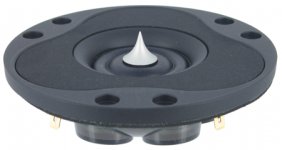In the German magazine "HOBBY-HIFI" 1/2011, page 59 and 60 is to read about the datas and individual characters of both dome tweeters, one without phase plug and the other with phase plug.
Who have heard both tweeters at the same time in the same two way combination ?
What are the audible pros and cons of an phase plug in such dome tweeters in general ?
Thank you for your comments.
http://www.scan-speak.dk/datasheet/pdf/d3004-662000.pdf
http://www.scan-speak.dk/datasheet/pdf/r3004-662000.pdf
Who have heard both tweeters at the same time in the same two way combination ?
What are the audible pros and cons of an phase plug in such dome tweeters in general ?
Thank you for your comments.
http://www.scan-speak.dk/datasheet/pdf/d3004-662000.pdf
http://www.scan-speak.dk/datasheet/pdf/r3004-662000.pdf
Attachments
Last edited:
Hi,
actually I use the D3004-660000 and I have never auditioned it in comparison to the ring radiator model. But there was no need to do so: The ring radiator has slightly higher distortion and, more important for my use model, the regular dome has a much wider dispersion. Just compare the 30° and 60° off axis responses. The ring radiator produces a pretty thin beam maybe 3KHz and up. Pretty high directivity. So check your design what you want/need.
actually I use the D3004-660000 and I have never auditioned it in comparison to the ring radiator model. But there was no need to do so: The ring radiator has slightly higher distortion and, more important for my use model, the regular dome has a much wider dispersion. Just compare the 30° and 60° off axis responses. The ring radiator produces a pretty thin beam maybe 3KHz and up. Pretty high directivity. So check your design what you want/need.
Hi,
actually I use the D3004-660000 and I have never auditioned it in comparison to the ring radiator model. But there was no need to do so: The ring radiator has slightly higher distortion and, more important for my use model, the regular dome has a much wider dispersion. Just compare the 30° and 60° off axis responses. The ring radiator produces a pretty thin beam maybe 3KHz and up. Pretty high directivity. So check your design what you want/need.
Thanks for reply. This I know all. The omnidirectional beam behaviour off axis (horiz. and vert. directivity) is without the ring radiator design clearly better. On the other hand, the dynamic behaviour is better, if the ring radiator design is present, especially by the use of low crossover frequencies and or low crossover slope <18db/oct. This is cause better avoiding break up effects of the dome/diaphragm, if there are peaks with high slew rate in the music signal.
I ask more concerning the audible impressions, not the physical differences.
Last edited:
Ok. This means to me that you are going to design a speaker around a tweeter ?
IMO the question is not which one "sounds" better. The question is what do you want to achieve ? These are both world class tweeters but two different animals.
Let me share 20+ years of experience with speaker design:
- First comes the application. How is the room ? Do you want to create a certain sensation ? You need to consider room- and psychoacoustics. And the answer should typically be a little more than "...should sound good".
- Then you need to find out how that translates into a speaker design. What do you need to achieve your goals ? Are there several possible ways ? Is it constant/controlled directivity or mixed ? wide dispersion or narrow, Sub/Sat, big box/small box/no box ?
- If all that is answered then comes the quest for suiting drivers.
And no matter how or what your speaker will be, a uniform off axis behavior between fu and fo should be on your priority list.
It is the speaker in its entirety that is responsible for audible impressions. Not a single tweeter in an otherwise wrong combination with other factors.
Maybe that can help you to spend big € for the right thing. If you want to build for fun and for learning, take a less expensive tweeter from the Discovery series or from SEAS. They cost a quarter but do not sound 4 times worse.
IMO the question is not which one "sounds" better. The question is what do you want to achieve ? These are both world class tweeters but two different animals.
Let me share 20+ years of experience with speaker design:
- First comes the application. How is the room ? Do you want to create a certain sensation ? You need to consider room- and psychoacoustics. And the answer should typically be a little more than "...should sound good".
- Then you need to find out how that translates into a speaker design. What do you need to achieve your goals ? Are there several possible ways ? Is it constant/controlled directivity or mixed ? wide dispersion or narrow, Sub/Sat, big box/small box/no box ?
- If all that is answered then comes the quest for suiting drivers.
And no matter how or what your speaker will be, a uniform off axis behavior between fu and fo should be on your priority list.
It is the speaker in its entirety that is responsible for audible impressions. Not a single tweeter in an otherwise wrong combination with other factors.
Maybe that can help you to spend big € for the right thing. If you want to build for fun and for learning, take a less expensive tweeter from the Discovery series or from SEAS. They cost a quarter but do not sound 4 times worse.
I have never liked the ring radiator, the D2904/7100 was my favourite SS tweeter before this one.
Did you compare the two?
Did you compare the two?
- Status
- Not open for further replies.

